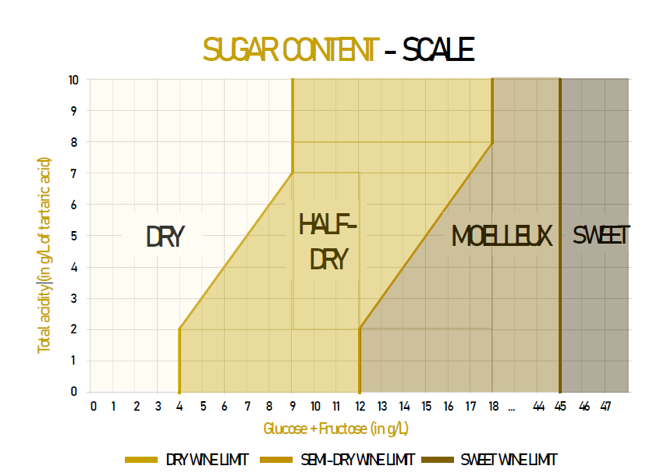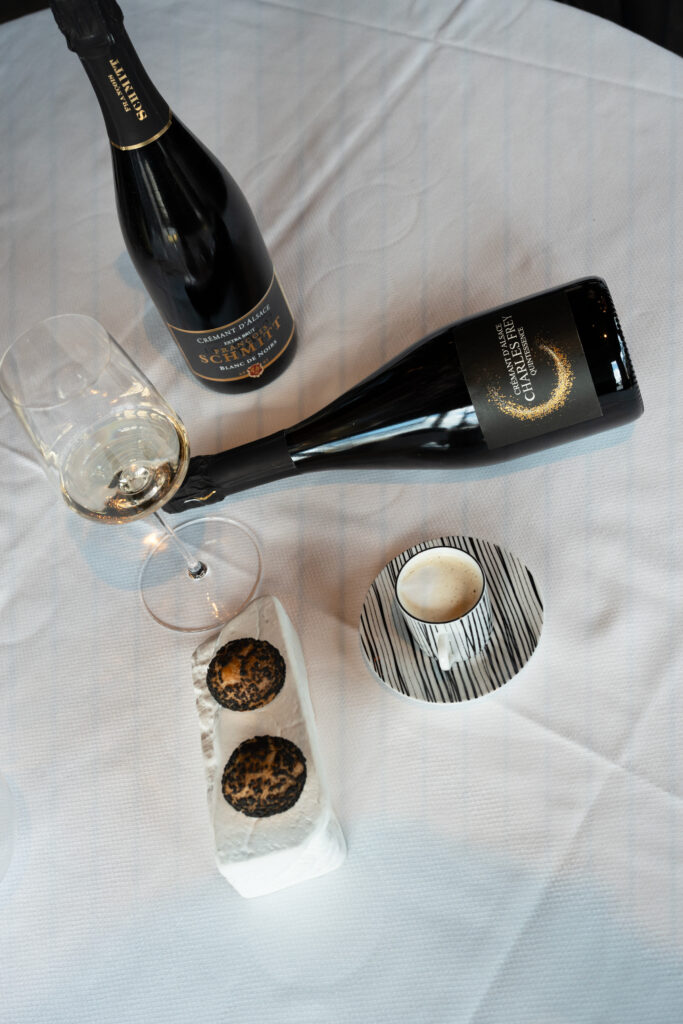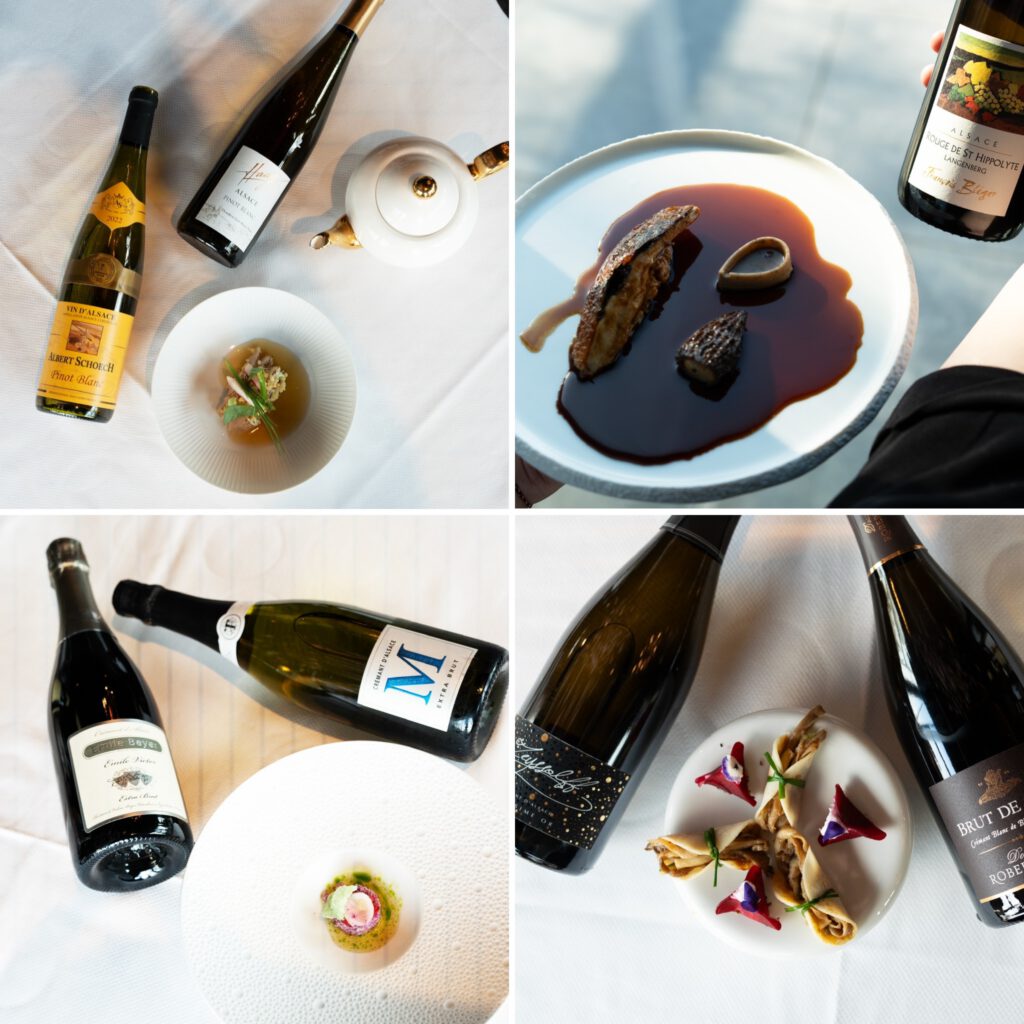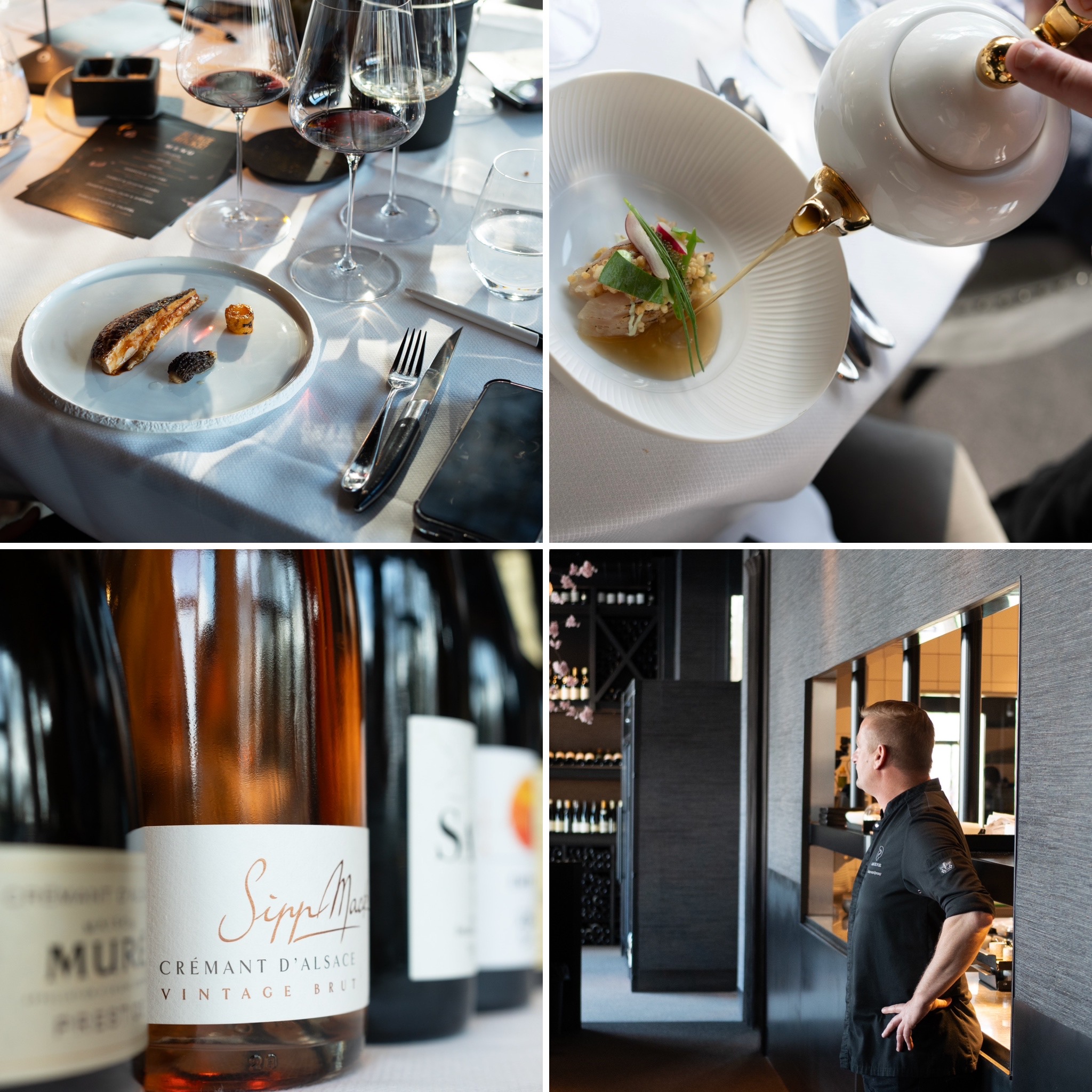Alsace – Moving from Sweet Pasts to Dry and Sunny Futures.
Think about the French Alsace and words like charming, cosy and sweetly come to mind. It is exactly this last word, that the Interprofessional Committee of Alsace Wines (CIVA) wants to get rid of. Our Alsace expert Benjamin Roelfs already proved the groundlessness of it in an earlier article, but it seems Alsace wines still got haunted by the bias being sweet and lumpy. While wine professionals know to value Alsatian treasures, modern consumers apparently still run into persistent stigmas.
It is about time to put Alsatian wines to the test. For this opportunity CIVA invited us to join a Masterclass on Alsatian wines, paired with an excellent lunch at Restaurant Aan de Poel.
We tasted a wide range of wines and lay them along the yardstick of modern wine consuming standards. We also discover latest trends and find out if Alsatian wines can fit into modern high class cuisines. Please read along, but mind your preconceptions.
Not like the Others
To understand what Alsace is about, we have to take a peek into its basic principles. We briefly highlight its geography, history, geology and conclude with its wide range of grape varieties.
Geography
Alsace is located in the northeasternmost corner of France, on the left bank of the Rhine River. The Alsace vineyards run along the flank of the Vosges, protecting them against dominant westerly winds. Due to this rain shadow the vines benefit an unprecedented amount of sun. According to Jancis Robinson, only the southern French cities of Béziers and Perpignan are sunnier and drier than the city of Colmar. Due to these favourable circumstances, Alsace has an unmatched amount of organic and biodynamic growers.
History
Alsace has had a turbulent history. Nowadays the Rhine River marks the border between France and Germany, but for centuries Alsace has been the subject of power play between these countries. Although Alsace ultimately ended up in French hands, German influences lingered around. These Saxon touches reappear in language, architecture, kitchen and not the least viticulture. The thin tall obligatory wine bottles (‘Flûte d’Alsace’) might be the most eye-catching legacy. And what to think about the very un-Frenche practice to centre the grape variety on the label?
Geology
Ancients geological movements have resulted in a jigsaw puzzle of soil compositions. Alsace winegrowers claim to have more than 800 different terroirs. There is sandstone, limestone, granite, gneiss, schist, and even more different soil types. These complex soil structures result in a wide variety of wine styles. It is not without reason Alsace has no less than 51 Grand Cru’s, not to mention the about 400 so called ‘lieux-dits’. At first glance Alsace may come across as an unassailable stumbling block, but it turns out to be a geological paradise for those who are willing to take a closer look and dig down deep.
Grape varieties
In Alsace a whole series of grape varieties is grown. Main grapes are Riesling, Pinot Gris, Gewurztraminer and Muscat – the so called noble grapes – completed with Pinot Blanc, Sylvaner, Chardonnay and Pinot Noir. Even Savagnin, Auxerrois and Chasselas can be found. Given the variations in ripening time, it might be no surprise harvest in Alsace is a complex logistical operation. Harvest usually starts mid-September and lasts until December for the so called Vendanges Tardives (‘VT’) and Sélection de Grains Nobles(‘SGN’). There are wines made from late harvested noble grapes. VT can vary from dry to sweet, SGN is sweet.

Curtailed Sugar
Talking about sweet, we have to mention the elephant in the room. Alsatian wines are sweet, right? Well, not exactly. Apart from VT and SGN, almost all Alsatian wines are dry. It is true some winemakers used to play with various degrees of sweetness. In the past even dry wines could have noticeable amounts of residual sugar. But, sweet times are over. To clear away the jumble of sweetness, the residual sugar level is mandatory stated on the label now. The grading depends on the amount of sugar in relation to the total acidity, as shown in the following image.

Studies show the average sugar level in Alsatian wines is decreasing. To experience that ourselves, we submit them to a litmus test. We taste a varied range of Alsatian wine and categorize our findings by trends we see.
Stand out Sparklings
The Mondial sparkling market is shifting and Alsace seems to benefit from it. The production of Crémant d’Alsace is exponentially growing. Crémant d’Alsace makes 33% of the total Alsace wine production and more than 50% of all French crémants comes from Alsace. Alsace has good cards, but should care not to overplay its hand. We share our thoughts.
Entry level crémants often are made from grapes sourced from the flat valley floor. Some of these wines undergo relative short maturation on the lees. The regulatory minimum sur lattes is 6 months. Studies however show that the impact of autolyse – the chemical reaction of decomposing yeast cells – starts to get noticeable from 18 months. We fear that crémants that fall short on distinctiveness will have a devil of a time to compete with low priced sparkling wines as for example Prosecco. Going cheap will come back to bite.
To be clear: entry level crémants are rock solid, but we think Alsace has the potential to distinguish itself and play a leading role in high quality sparkling wines. The evidence already is there. The best examples of Crémant d’Alsace go beyond the bounds. They are (bone) dry, have adequate acids and have earned complexity by long lee aging do reflect the terroir. Nice examples are the Cuvée Emile-Victor NV by Domaine Emile Beyer (Cour du Vin), Blanc de Noir Dosage Zéro 2020 by Domaine Fernand Engel (Poot Agenturen) and Millésimé OR 2013 by Maison Zeyssolff (importer unknown).

Weightless Whites
Alsace white wines are talking about fruit. Modern Alsatian winemakers do understand that fruit is not an equivalent to sugar. Modern Alsatian wines lose weight, without losing fruit. And the best part is, it happens across the board. Perfect example is the Pinot Blanc Lieu-dit Sand 2022 by Domaine Barmès-Buecher (Karakter Wijnimport) . This wine shows filling fruits whilst being fresh (5,94 g/l TA) and dry (2,2 gr/l RS). Truly dry is the orange Pinot Gris by Maison Jean-Baptiste Adam called ‘Empreinte’ (Gall & Gall). This well balanced orange wine has no residual sugar at all and is amazingly characterful and gastronomic.
Riesling is King in Alsace. A trained king to be precise. Grand Cru Hengst Riesling 2021 by Domaine Saint-Remy (Robbers & Van den Hoogen) for example is banging precise, showing electrifying acids (7 g/l TA) and only having 3 grams of residual sugar. Even traditional wineries face weight-reducing treatments. Grand Cru Schlossberg Riesling 2021 by Domaine Weinbach (Résidence Wijnen) is incredible concentrated and deep, being simultaneously weightless and precise.
Trendy Reds
It’s getting hot in Alsace and that is great news for red wine enthusiasts. The planting of blue grapes increases. Although some winemakers already experiment with other grape varieties, Pinot Noir currently is the sole allowed grape variety in Alsace. These wines improve at lightning speed. The Grand Cru vineyards Hengst and Kirchberg de Barr already allow Pinot Noir and the Grand Cru Vorberg is expected to follow. Our overall impression is that the quality bar of the Alsatian red wines is set high. Times of non-saying fruity thirst quenchers are over. Alsatian red wines deliver great quality for a very decent price. Nice examples are Cuvée Mathieu 2021 by Domaine Kirrenbourg (Luiten Wijn) and Lieu-dit Bollenberg 2020 by Domaine Bernard Haegelin (Bubbels Meester).

Greatly Gastronomic
Alsace is known for its traditional and rustic cuisine dominated by pickled cabbage and meaty peasantry plates. Perfect to pair with traditional fluffy wines – preferably served in traditional Alsatian wineglasses – but what about modern Alsatian wines? Two Michelin star chef Stefan van Sprang: ‘modern Alsatian wines do pair perfectly with our light, inventive and eclectic cooking style.’
To prove that, the sommeliers of Restaurant Aan de Poel paired their dishes with Alsatian wines. It is no exaggeration to say they succeeded to make celestial pairings, each one more beautiful than the last. From an aray of amuses with uplifting crémants to black cot with a savoury Pinot Gris Clos Rebberg 2022 by Domaine Philippe Sohler (Cour du Vin) and from turbot with an outstandingly balanced Grand Cru Altenberg de Bergheim Riesling 2019 by Gustave Lorenz (Kwast Wijnkopers) to guineafowl with a Burgundy minded Lieu-dit Langenberg 2022 by Domaine François Bléger (Thiessen Wijnkoopers).

Alsace: The Vibrant Future of Wine’s Best-Kept Secret
We conclude by saying that Alsace is one of the most intriguing wine growing areas we know. It ticks al the boxes of modern wine consumption, but the customer don’t seem to realize yet. It is up to Alsace to stay focussed and stand its ground. Quality above quantity and eye on the ground. When the terroir gets the microphone, grounds will tremble. Alsace rocks, one time symphonic and the other time psychedelic, one time romantic and the other time progressive. One thing is for sure: it won’t get boring.
This article was written by our own Hermen Jansen, in response of a masterclass on Alsatian wines by Edwin Raben, followed by a lunch at two Michelin star Restaurant Aan de Poel on invitation of the Interprofessional Committee of Alsace Wines (CIVA) and Pitch PR. Picture credits: Wesley Olland.

